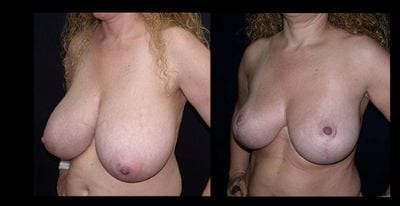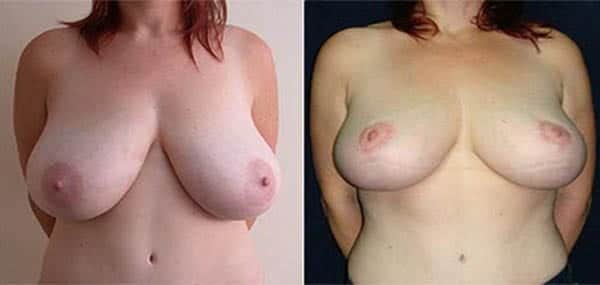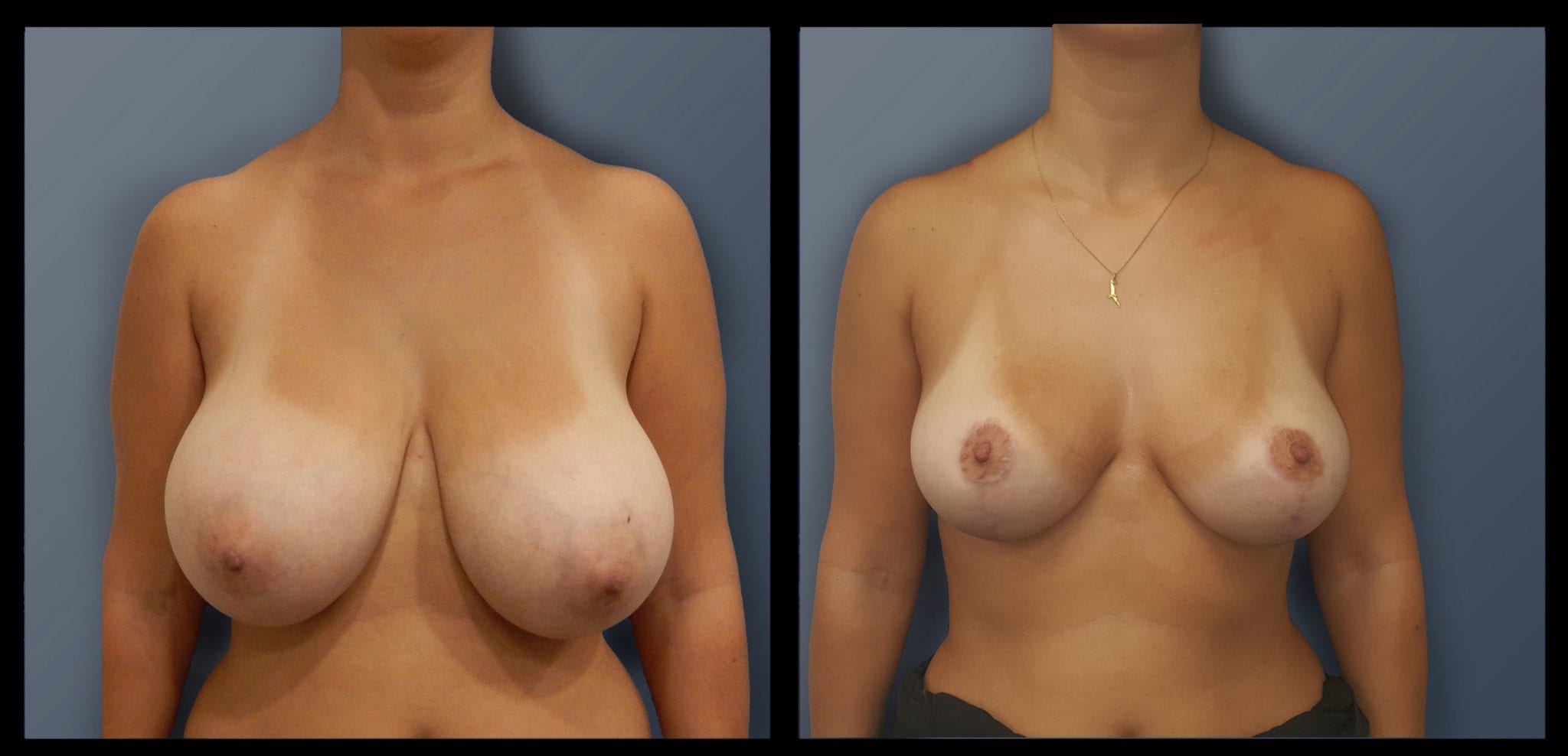Breast Reduction Who is the surgery for?
Breast reduction surgery is intended for all women, at any age, who ``suffer`` a great play (hypertrophy). These women suffer from excess weight on the chest, complain of sensitivity and pain in the shoulder belt, complain of pressure signs of the bra on the shoulders and the need to live only with a bra. Sometimes women complain of itching and seasonal redness under the breast and a social aesthetic problem.


Breast Augmentation Before and After (Example B)
Tips for Breast Reduction Surgery:
- In most breast reduction surgeries, the breast is also raised
- Most women with large breasts want to reduce the breast sometimes even beyond the size of proportionally – “as small as possible” because of years of suffering and respectable breasts. It is not always advisable to cut the breasts to a minimum size, since after getting used to the “new” breasts, they may be too small.
- Too little breasts will be corrected by a silicone implant.
- Beautiful breasts are not necessarily very raised breasts and have a spherical appearance
- Women with increased risk and family history of breast cancer are advised to lower breasts and thus reduce the risk of cancerous tumors.
- Breast reduction will do minimal scars
An “anchor” scar that includes a lateral scar and the sub-fold of the breast is the most problematic scar. This scar will appear on the side of the chest (on the sides of the breasts) and on the neckline (at the junction between the breasts). - The best “best” scars in the best form of healing will be around the glans and vertical from the fold to the fold (usually invisible).
It is very helpful to avoid the scar in the fold of the sub-dummy (need high skill of the surgeon) - Most breasts do not lose their nipples
- Even after breast reduction, a “drop” of the breast may occur
Preoperative assessment
1. For every woman over the age of 40, it is recommended to obtain mammography before breast reduction surgery for comparison purposes.
2. Measure the quality and quantity of the breast tissue at the top and bottom of the breast and below the nipple. We evaluate skin quality and stretch marks. Another important measurement is coronal diameter. In many cases, breast prolapse and its size are accompanied by coronal expansion that requires surgical repair.
3. Prior to surgery, decide what breast image you want. We try to reduce the breast to the appropriate dimension to the structure
4. Your body at your request. Breast reduction surgery is performed in a hospital under general anesthesia. The surgery takes about an hour and a half. During surgery, we usually reduce the diameter of the glans and raise the glans and nipples on the stem to its new location. The stem contains blood vessels and nerves that reach the nipple. With breast reduction, excess fatty tissue and milk glands are removed. The sebaceous glands that remain attached to the narrow stem attached to the nipple enable the production of milk, but in a limited and insufficient amount for breastfeeding. We create a ``hammock`` that supports the breast in the lower part and forms a fill near the groove between the two breasts. We send the extra tissue for pathological examination. At the end of the surgery, we sew internal threads and absorb so that there is no need to remove stitches and no stitch marks on the skin surface. We wear a sports bra that is not lowered for about 3 weeks. In most breast reduction surgeries performed by us, we do not leave drains and there is no need for prolonged hospitalization. Return to routine is among the shortest of all plastic surgery and takes only a few days.
2. Measure the quality and quantity of the breast tissue at the top and bottom of the breast and below the nipple. We evaluate skin quality and stretch marks. Another important measurement is coronal diameter. In many cases, breast prolapse and its size are accompanied by coronal expansion that requires surgical repair.
3. Prior to surgery, decide what breast image you want. We try to reduce the breast to the appropriate dimension to the structure
4. Your body at your request. Breast reduction surgery is performed in a hospital under general anesthesia. The surgery takes about an hour and a half. During surgery, we usually reduce the diameter of the glans and raise the glans and nipples on the stem to its new location. The stem contains blood vessels and nerves that reach the nipple. With breast reduction, excess fatty tissue and milk glands are removed. The sebaceous glands that remain attached to the narrow stem attached to the nipple enable the production of milk, but in a limited and insufficient amount for breastfeeding. We create a ``hammock`` that supports the breast in the lower part and forms a fill near the groove between the two breasts. We send the extra tissue for pathological examination. At the end of the surgery, we sew internal threads and absorb so that there is no need to remove stitches and no stitch marks on the skin surface. We wear a sports bra that is not lowered for about 3 weeks. In most breast reduction surgeries performed by us, we do not leave drains and there is no need for prolonged hospitalization. Return to routine is among the shortest of all plastic surgery and takes only a few days.

Breast Augmentation Before and After (Example C)

Scars
In breast reduction surgery there are several methods of surgery. In principle, the methods are divided into surgery that leaves a scar around the coronal and only a vertical scar (in the painting on the right) and the surgery that leaves in addition to these scars also a lateral scar at the breast fold (the anchor shape). Each method has advantages and disadvantages, which should be discussed individually before surgery. However, due to advances in surgical methods of the breast, it is now common to perform surgery without prominent and restrictive scars (such as the scar along the breast fold). These scars are ``hidden`` by the fold, but are prominent and very visible on the chest surface from the sides of the breast (most prominent with a swimsuit) or on the inside of the breasts (more prominent in the cleavage and very difficult to conceal). The surgical method can vary from one patient to another Depending on the shape of the breasts, the type and quality of the skin, the amount, thickness and elasticity of the soft tissue. Final results after this surgery are made after only a few months. In the first months the breast may look different and different from its final shape.
** Complications and side effects
- As with any surgery, there are possible complications. The main ones are:
- Necrosis of the nipple partially or fully. An increase in this complication rate increases with greater excision. In any case, this is a very rare complication and its rate is less than 1%
- Hemorrhages account for about 3% of all operations performed
- Infection in the surgical wound is less than 1% of all operations. After surgery, we recommend taking preventive antibiotics for 5 days to reduce the risk of infection.
- The need for repeat surgery for repair exists mainly in surgery with a longitudinal scar only, due to its conservative nature and the desire to avoid unnecessary scars. The rate of repairs here is about 2%.
- Reduction of sensation to the nipple area, less than 5% of cases. Usually the feeling returns until a year after surgery, and in a minority of cases the feeling is not restored. An increase in this complication rate increases with greater excision.
- Breastfeeding can be impaired, although it is not possible to determine with certainty which rate.
- Separation of the edge of the incision and the opening of the seam line. A rare phenomenon that is more related to the removal of large breast mass with thin skin and women who smoke** Side effects will be discussed extensively with doctors before surgery
Follow-up after breast reduction
After breast reduction, the permanent program for early detection of breast cancer should be continued. The program includes self-examination, examination by a breast surgeon, mammography or ultrasound according to the rules set by the Ministry of Health. Before the examination, you should inform your doctor about the surgery you have undergone. Early Detection Breast Cancer In general, it is recommended that you consult your surgeon or any other plastic surgery specialist for any changes in the breast.
We want to see our amazing results Breast reduction?
Are ready to receive advice and guidance regarding Breast reduction?
You can call us at 1700-506-504 or leave details here and we will get back to you soon!

